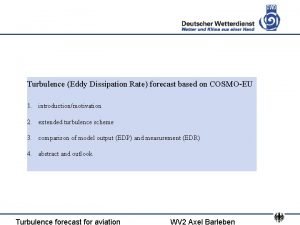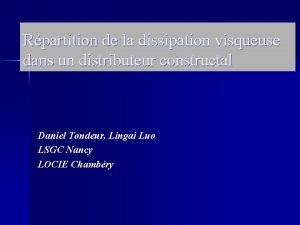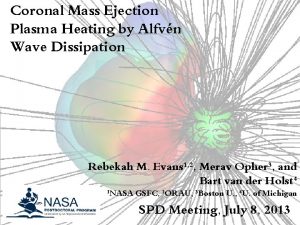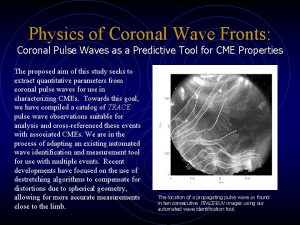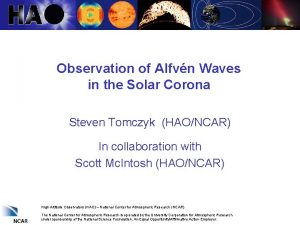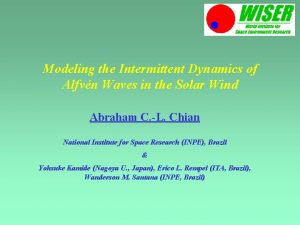Dissipation of Alfvn Waves in Coronal Structures Coronal













- Slides: 13

Dissipation of Alfvén Waves in Coronal Structures Coronal Heating Problem Tcorona~106 K Tphotosphere~6 x 103 K M. F. De Franceschis, F. Malara, P. Veltri Dipartimento di Fisica Università della Calabria

In the Solar Corona S>109 very low dissipation coefficients How to efficiently are waves dissipated before they leave the corona? Energy Dissipation Rate l= characteristic velocity and magnetic field variation scale An efficient dissipation is possible if small scales are created In a 3 D-structured magnetic field small scales can be efficiently creted by phase-mixing mechanism [Similon & Sudan, 1986] 23 -28 September 2003 Basic Processes in Turbulent Plasmas

The model ▪Alfvénic perturbations propagating in a 3 D magnetic field equilibrium structure ▪In the Corona Cold Plasma B must be a force-free field ▪We assumed 23 -28 September 2003 (linear force-free field) Basic Processes in Turbulent Plasmas

xy=base of the ▪Planar geometry in which the curvature is neglected Corona z=vertical direction L=periodicity lenght ▪Statistical homogeneity in horizontal directions We assumed periodicity along x and y directions ▪

Equilibrium Magnetic Field is a superposition of several Fourier components The choice of these parameters determines a particular solution of the problem

▪ determines both the current density and the maximum lenght In order to respect the statistical homogeneity so we used ▪ [Pommois et al. , 1998] randomly chosen in the range [0, 2π] ▪ The magnetic field is generated by a turbulent process. Assuming a spectral energy density We get

Wave evolution equations in a inhomogeneous plasma Alfvénic perturbations propagate in the above magnetic equilibrium. HYPOTESIS: (1) Cold plasma (2)Small wavelenght with respect to the typical lenght scale (3) WKB approximation (4)Alfvénic perturbations are decomposed as a superposition of localized (5)wave packets

Magnetic field at the coronal base • Red tones indicate the field lines flowing out the coronal base, while blue tones the flowing in • Statistic homogeneity respected 23 -28 September 2003 Basic Processes in Turbulent Plasmas

Magnetic field structure • This figure is obtained by planning 70 packet trajectories • Each line connects a positive polarity zone with a negative one • Some lines follow a brief journey, other ones follow longer and more complicated trajectories 23 -28 September 2003 Basic Processes in Turbulent Plasmas

Magnetic Field Topology • Flux tubes obtained by calculating the magnetic lines starting from a small circle at the coronal base • “compact” flux tube The initial circle is mapped in a closed curve onto the coronal base 23 -28 September 2003 • “broken” flux tube The magnetic surface separates into various sheets At break points stretching of Alfvénic packets Basic Processes in Turbulent Plasmas

Packet Time Evolution • The wavevector k as a function of time t, for a given packet • Almost exponential growth • The energy e as a function of time t, for a given packet, at S=105 • Dissipation within few Alfvén times 23 -28 September 2003 Basic Processes in Turbulent Plasmas

Dissipation Time Scaling Law • The dissipation time td as a function of the Reynolds number S, for a given packet • The scaling law is asymptotically verified for large S 23 -28 September 2003 Basic Processes in Turbulent Plasmas

Conclusions n Coronal heating due to Alfvén waves dissipation n Linear force-free magnetic field in equilibrium configuration (statistic homogeneity hypotesis) n Evolution equations for an Alfvén waves packet in a inhomogeneous cold plasma: small scale generation n Magnetic field topology: sites of magnetic lines exponential separation n Wave vector increase and energy decrease n Scaling law of dissipation time 23 -28 September 2003 Basic Processes in Turbulent Plasmas recovered
 Europe turbulence forecast
Europe turbulence forecast Transistor power dissipation
Transistor power dissipation Daya disipasi
Daya disipasi Velocity dependent potential and dissipation function
Velocity dependent potential and dissipation function Dissipation test
Dissipation test Dissipation visqueuse
Dissipation visqueuse Power dissipation
Power dissipation Inverter loading ratio
Inverter loading ratio Long waves and short waves
Long waves and short waves Is a seismic wave mechanical or electromagnetic
Is a seismic wave mechanical or electromagnetic Differences between mechanical and electromagnetic waves
Differences between mechanical and electromagnetic waves Mechanical waves vs electromagnetic waves
Mechanical waves vs electromagnetic waves Mechanical waves examples
Mechanical waves examples Compare and contrast p waves and s waves using venn diagram
Compare and contrast p waves and s waves using venn diagram
